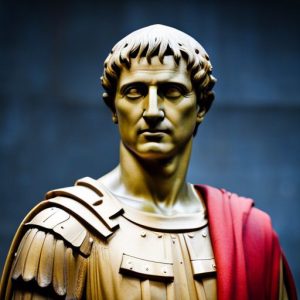

Meet Augustus Caesar, one of the most remarkable individuals in the history of Rome. Born as Gaius Octavius in 63 BC, he inherited great wealth and political power from his great-uncle Julius Caesar after he was assassinated when Augustus was only 18 years old. He quickly established himself as an outstanding politician and military leader, and at age 19, he joined forces with Mark Antony and Marcus Aemilius Lepidus to form the Second Triumvirate.
Augustus’s reign was marked by significant reforms and innovations that transformed Rome into a prosperous and peaceful empire. He restructured the Roman government, implementing a system of provinces and establishing a civil service to manage them. He also introduced a new currency system and constructed an extensive network of roads and aqueducts that connected far-flung territories.
Augustus was a patron of the arts and architecture, commissioning many of the great works of the time, such as the Mausoleum of Augustus, the Temple of Caesar, and the Ara Pacis. His leadership brought a period of peace and prosperity known as the Pax Romana, which was characterized by unprecedented economic growth and social stability.
Despite his many accomplishments, Augustus’s reign was not without controversy. He faced several challenges to his authority, including a revolt led by his daughter Julia’s ex-husband, and a rebellion in Germany led by Arminius. He was also criticized for his authoritarian rule and the ruthless tactics he used to maintain his power.
Augustus Caesar’s impact on Rome and the world cannot be overstated. His legacy lives on in the many structures and monuments he commissioned and in the numerous reforms and innovations he introduced during his reign. Even today, Augustus remains a fascinating and influential figure, and his contributions to history continue to inspire and captivate people worldwide.
